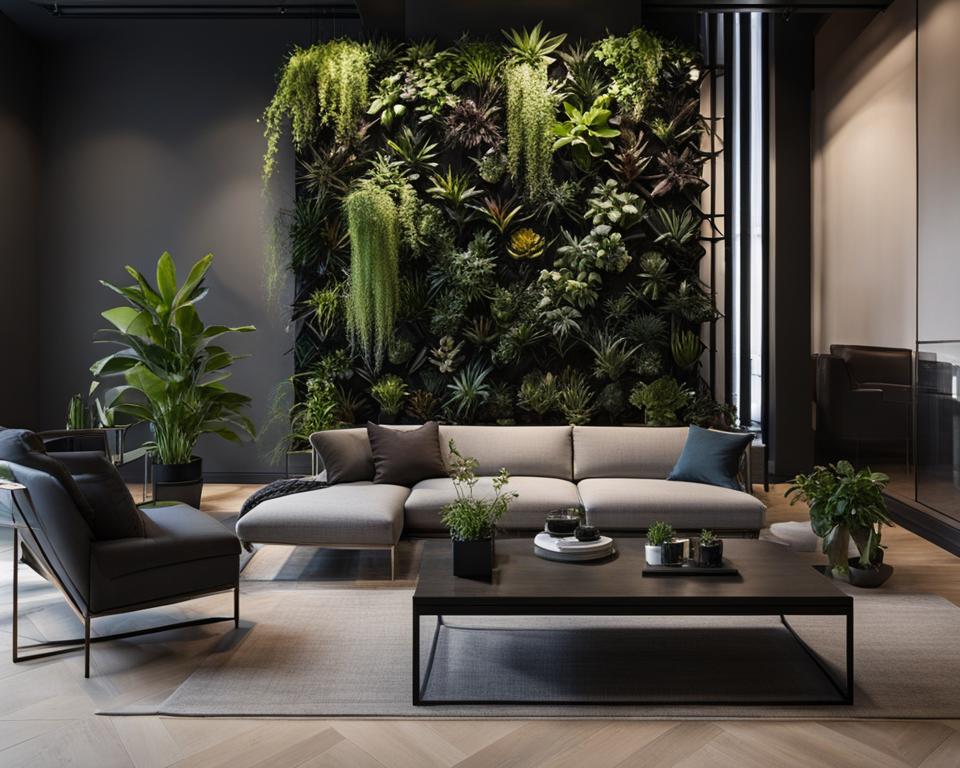Imagine transforming your home into a lush oasis where the verdant arms of nature reach up your walls, inviting an evergreen spirit into your urban dwelling. Indoor vertical gardening is not just an aesthetic delight; it’s a practical revolution for city residents who dream of gardening but are constrained by the lack of outdoor space. Whether you’re faced with the limitations of an apartment, or you’re an individual seeking an accessible way to cultivate your own food, your vertical indoor garden becomes more than decor—it’s a step towards sustainability and self-reliance.
With the advent of vertical gardening indoors, you now have the power to bypass traditional agricultural challenges and harvest fresh ingredients right from your living room, kitchen, or even balcony. This method turns every sliver of space into a potential botanical venture, from sleek DIY wall mounts to innovative commercial systems. Experience the year-round bounty of your own green thumb efforts and savor the crisp taste of home-grown fruits and herbs, while also contributing to a greener planet.
Key Takeaways
- Seize control of limited living spaces by incorporating indoor vertical gardening into your home design.
- Embrace the numerous benefits, such as a year-round fresh supply of produce and an enhanced connection with nature.
- Explore the versatility of vertical gardening with both DIY options and high-tech systems tailored to your lifestyle.
- Cultivate a variety of plants, from delectable strawberries to aromatic herbs, to enrich both your palate and living space.
- Enhance your well-being with the tranquility and air-purifying qualities of an indoor vertical garden.
Embracing Vertical Gardening Indoors for Space Maximization
If you’re looking to transform your home into a lush oasis without sacrificing valuable square footage, indoor vertical gardening techniques may be the solution you’ve been searching for. Often the challenges of living in apartments, condos, or small spaces are the limitations in terms of horizontal landscape. However, with the adept use of vertical space, you can cultivate a diverse range of plants, from decorative houseplants to nutritious edibles. Benefits of indoor vertical gardening include not just an aesthetic enhancement of your living space but also the maximization of your green footprint within a limited area.
Vertical gardening indoors unlocks creative possibilities to integrate greenery into your environment. It’s not only about aesthetics; these gardens can actually contribute to your household’s fresh produce. Consider the satisfying crunch of lettuce or the zesty flavor of fresh herbs right from your wall garden—these are just a few advantages this approach offers.
Let’s look at some innovative ways to create your own vertical garden:
- Hanging Pots: They can be suspended from the ceiling or attached to walls, saving floor space and adding levels of plants to your room.
- Shelf Systems: Shelves are a perfect way to display a collection of smaller plants, and they can be customized to fit any indoor space.
- Stackable Planters: These are great for growing herbs, strawberries, and even certain vegetables. They’re also easily expandable as your garden grows.
- Hydroponic Systems: These soil-less systems are a step up for those looking to maximize plant yield in a limited space and can be a focal point for any room.
Going the DIY route can be as simple as repurposing containers you already have into planters or experimenting with trellises and climbing plants. For those willing to invest a bit more, hydroponic options offer a cleaner and often more productive indoor garden. Whichever method you choose, the vertical approach is certain to bring a new dimension to your indoor living space.
| Technique | Best for | Consideration |
|---|---|---|
| Hanging Pots | Herbs, Ferns, Small Flowers | Ensure strong ceiling/wall mounts |
| Shelf Systems | Succulents, Cacti, Houseplants | Access to light; regular watering |
| Stackable Planters | Strawberries, Leafy Greens | Vertical space use; easy harvesting |
| Hydroponic Systems | Tomatoes, Bell Peppers, Cucumbers | Initial setup cost; electricity for pumps |
In sum, the benefits of indoor vertical gardening range from space-saving design to the sheer joy of growing your own food. Whether it’s a spruced-up corner with dangling spider plants or an elaborate hydroponic setup, these gardening solutions are as functional as they are decorative, promising a rewarding experience for budding gardeners and seasoned growers alike.
Reaping the Multiple Benefits of Indoor Vertical Gardening
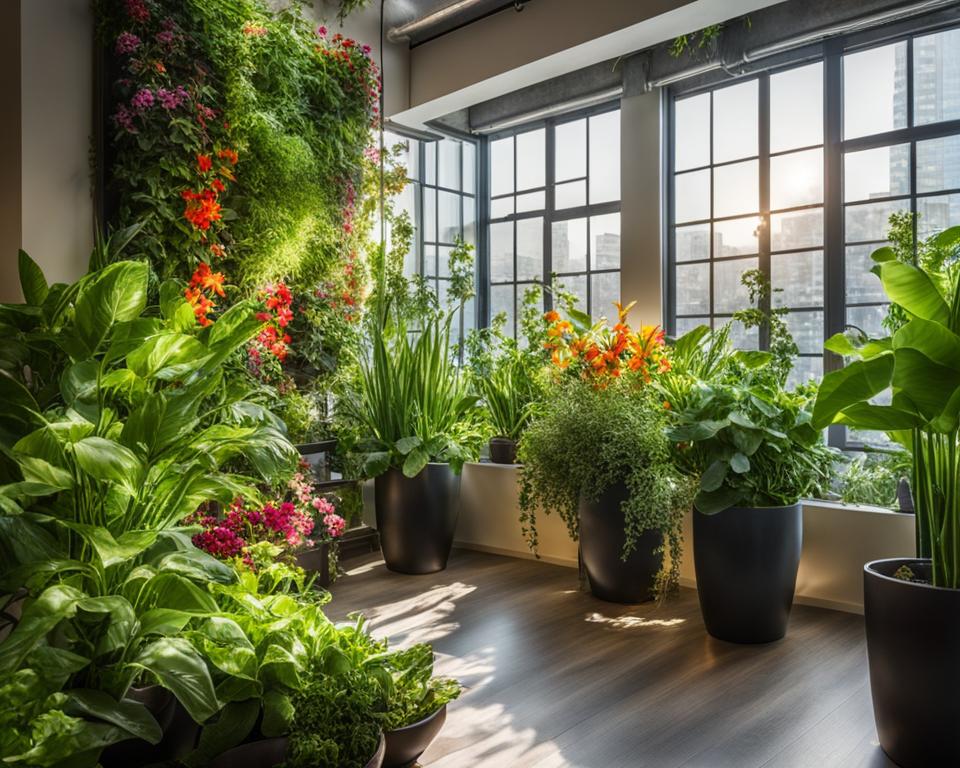
Embarking on the journey of vertical gardening indoors is more than just a home improvement project; it’s a pathway to a healthier, more sustainable, and efficient way of living. Before we delve into the specifics, let’s consider why embracing these innovative gardens can be so transformative for your urban dwelling.
Enhancing Mental Well-Being with Green Living Spaces
Did you know that incorporating greenery into your living space can dramatically improve your mental health? Indoor vertical gardens serve as natural air purifiers and bring a calming, serene slice of nature into your home. The verdant hues and textures provide not just visual pleasure but also contribute to reduced stress levels and increased feelings of well-being. As you learn how to start vertical gardening indoors, you’ll discover the joy and satisfaction of nurturing life within your four walls.
Year-Round Cultivation: Breaking Seasonal Growing Barriers
Unlike traditional gardens that succumb to the whims of weather, vertical gardening indoors offers you the ability to cultivate fresh herbs, vegetables, and ornamental plants all year long. These innovative gardening systems bypass seasonal limitations and harsh outdoor conditions, giving you perpetual access to homegrown, pesticide-free produce right at your fingertips.
Space Efficiency: Vertical Gardens in Urban Settings
In the past, the thought of gardening in a compact urban apartment might have seemed far-fetched. Not anymore! Vertical gardens use the seldom-utilized vertical space in your home, making them perfect for places where the square footage is at a premium. You can now grow lush green plants and even produce in the tiniest of spaces. An added benefit to note in your tips for successful vertical gardening indoors is how these gardens can act as an aesthetic feature, enhancing the ambiance of your living space.
Eco-Friendly Aspects of Indoor Vertical Gardening
Vertical gardens aren’t just good for you; they’re also good for the planet. With more people seeking eco-friendly living options, vertical gardening provides an excellent solution. By utilizing vertical space and often requiring less water through recirculation methods, these systems reduce waste and promote sustainability. What’s more, they often eliminate the need for chemical pesticides, ensuring that your home environment remains toxin-free.
| Benefit | Description | Impact |
|---|---|---|
| Mental Well-being | Natural air purification and stress reduction | Improved quality of life and health |
| Year-Round Cultivation | Freedom from outdoor growing seasons | Continuous supply of fresh produce |
| Space Efficiency | Aesthetic greenery without the large footprint | Maximized living space utilization |
| Eco-Friendly Approach | Sustainability through reduced water and no pesticides | Lower environmental impact |
Thus, whether you’re a seasoned gardener or a green-thumbed newbie, the advantages of setting up a vertical garden inside your home are plentiful and profound. And now, with these insights, you’re equipped with knowledge on how to start vertical gardening indoors effectively!
Curating the Best Indoor Vertical Garden Ideas
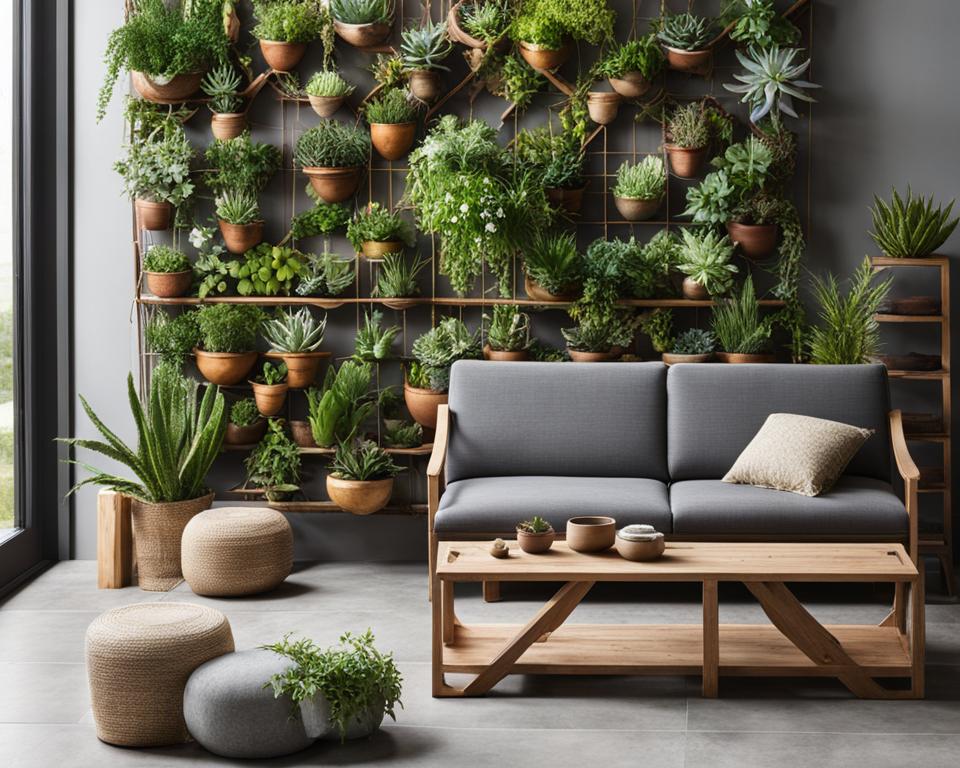
Transforming your home with greenery not only beautifies your living space but also promotes a healthier environment. Embracing indoor vertical gardening for small spaces does not require extensive acreage; even a modest apartment can be converted into a lush retreat. Discovering the best indoor vertical garden ideas begins with a careful selection of plants that complement your interior aesthetic while being functional and easy to care for.
Top Edibles to Cultivate in Your Indoor Vertical Garden
Your vertical garden can be more than just a visual treat; it can be a source of your daily greens, herbs, and fruits. Consider plants that not only thrive in vertical planters but also provide fresh, organic produce right from your wall to your plate.
- Strawberries for a sweet and visually striking addition
- Lettuce varieties that grow quickly and require minimal space
- Cherry tomatoes for that burst of flavor and color
- A variety of herbs like basil, mint, and chives for aromatic freshness
Decorative and Functional Plant Choices
Plants that purify air, add a pop of color, or double as edible delights can transform and elevate your vertical garden. Balance your selection with a mix of functional and ornamental species to create a vibrant tapestry of foliage and blooms.
| Plant Type | Decorative Value | Functional Benefit |
|---|---|---|
| Edible Flowers | Vibrant and attractive | Edible; adds flavor to dishes |
| Ferns | Lush and green | Air purification |
| Dwarf Vegetables | Compact and colorful | Space-efficient edibles |
Whether you opt for a minimalist herb rack or a grand affair of tiered hydroponic towers, your indoor vertical garden can become the centerpiece of your home. Cultivate a personal oasis that brings both beauty and bounty to your living space, proving that even the smallest of spaces can harbor the most inspiring of gardens.
Exploring Techniques for Successful Vertical Gardening Indoors
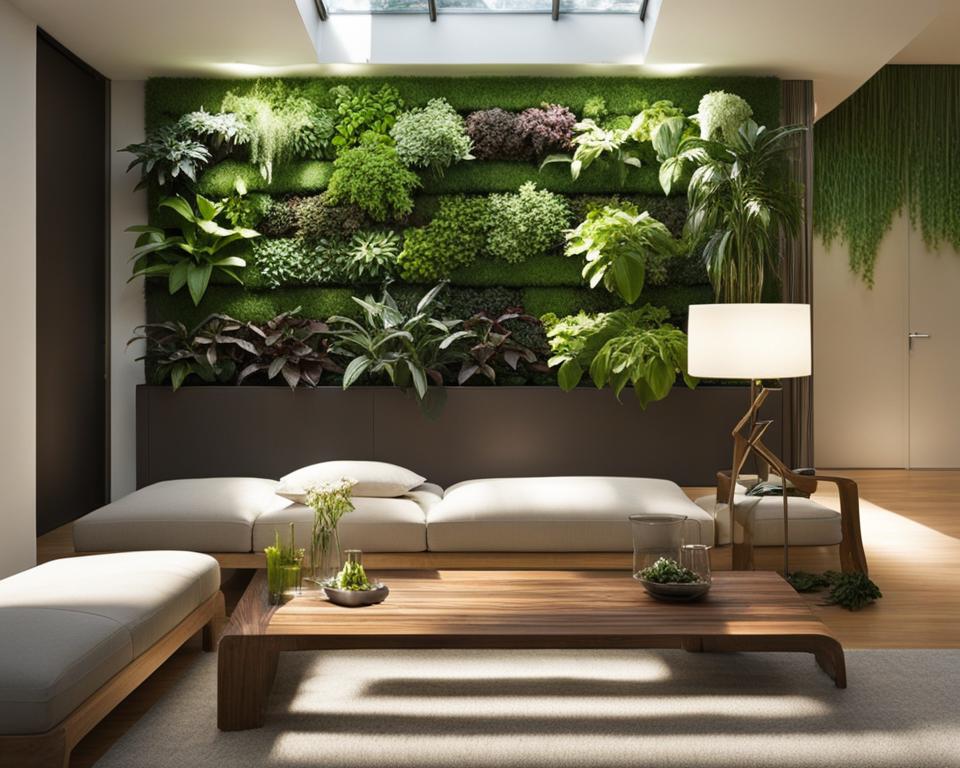
As you dive into the world of indoor vertical gardening, it’s crucial to identify which vertical gardening techniques will flourish in your unique space. A successful setup begins with selecting the right approach to maximize both the aesthetic appeal and the functional benefits of your indoor garden.
Beginners may start with the basics, such as:
- Hanging pots on sturdy hooks
- Attaching rows of shelves to bright walls
- Mounting mason jars or modular planters
In contrast, experienced gardeners might opt for more advanced systems:
- Hydroponic towers with built-in grow lights
- Vertical aeroponic setups for efficient plant nutrition
Regardless of the route you choose, the benefits of indoor vertical gardening are plentiful. You’ll not only enhance your living space with vibrant greenery but also have the added pleasure of growing fresh produce right at home. Here’s how you can categorize different vertical gardening methods:
| Technique | Difficulty Level | Space Required | Expected Yield |
|---|---|---|---|
| Wall-Mounted Planters | Beginner | Minimal | Moderate |
| Stackable Pots | Intermediate | Small to Moderate | High |
| Hydroponic Systems | Advanced | Moderate to Large | Very High |
The customization doesn’t end there. For those with a knack for DIY projects or an eye for design, the sky—or rather the ceiling—is the limit! By integrating lighting systems into your shelves, you can ensure your plants thrive while creating a cozy, luminous environment. Explore various potting materials from classic clay to modern, self-watering designs for a garden that reflects your personal style.
When embarking on your vertical gardening venture, consider these points:
- Assess your available light and adjust with supplemental lighting if necessary.
- Choose plants that suit your climate and indoor conditions.
- Invest in a watering system that ensures even moisture distribution.
- Don’t forget about weight; ensure your walls can support your lush new garden.
With the right setup, indoor vertical gardening can transform not just the aesthetics of your home, but also contribute to a sustainable lifestyle. Embrace the upward growth and enjoy the fruits (and vegetables) of your labor!
Beginner’s Guide: How to Start Vertical Gardening Indoors
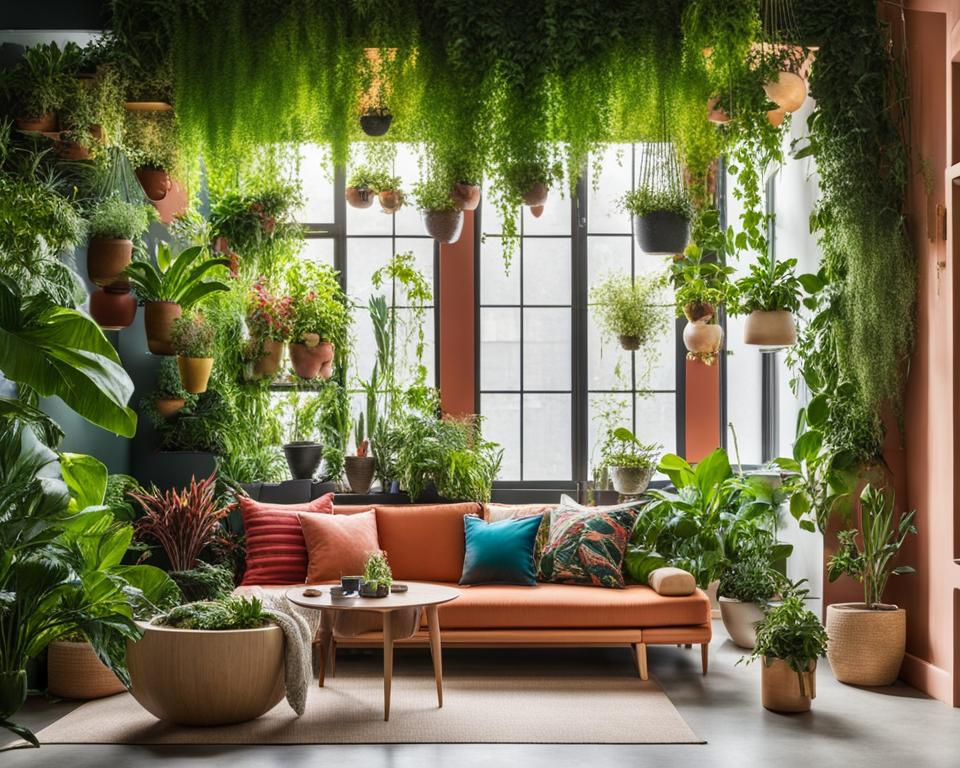
Embarking on the journey of indoor vertical gardening can be a rewarding endeavor, especially when you’re looking to maximize your living space with fresh greenery or homegrown edibles. To get started with vertical gardening indoors, the secret is in beginning with a simple system that aligns with your space and experience level.
First and foremost, you’ll want to scout out the perfect spot in your home. A location with sufficient natural light is essential for most plants, although some will thrive with artificial lighting if sunlight is sparse. After finding a suitable location, consider the type of vertical garden that will best fit your space. Many beginners find success with wall-mounted pocket gardens or hanging pots, which are not only easy to set up but also very space-efficient.
Choosing the right plants is just as important as the setup itself. Herbs, lettuce, and strawberries are excellent starter plants for your vertical garden due to their relatively easy care and compact growth habit. They can provide the thrill of quick results, which is always encouraging for novice gardeners.
For those who prefer a straightforward approach, the Aerogarden kit is a popular choice. This all-in-one system takes the guesswork out of how to start vertical gardening indoors, providing everything you need from seeds to lighting. Consider it like training wheels for the aspiring indoor gardener; it helps you learn the ropes with less risk of mishap.
- Select an appropriate location with good lighting
- Choose a simple setup like hanging pots or pocket gardens
- Opt for easy-to-grow plants like herbs and leafy greens
- Consider a starter kit to streamline the process
By focusing on easy-to-manage projects, you’ll not only gain confidence but also enjoy the process of watching your vertical garden flourish. So, take that first step towards transforming your indoor space with a lush, vertical landscape that’s both beautiful and bountiful!
Insider Tips for Nurturing a Thriving Vertical Indoor Garden
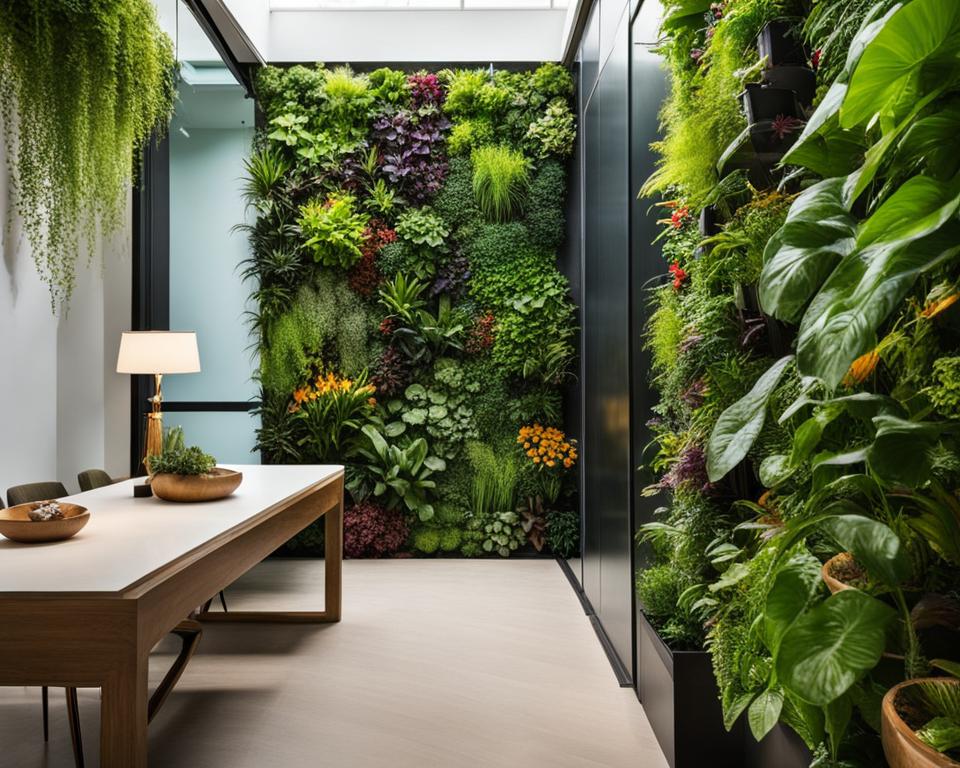
Embarking on the journey of vertical gardening indoors can bring abundant rewards if you manage to master a few key conditions critical to your garden’s success. Adjusting the environment to meet the needs of your chosen plants will play a significant role in cultivating a lush and productive indoor oasis.
Optimizing Light and Temperature for Indoor Growth
One of the essential tips for successful vertical gardening indoors lies in providing your plants with sufficient light. While natural sunlight is ideal, it’s not always possible in every indoor setting. Consider the use of grow lights that mimic the spectrum of sunlight, positioning them to ensure each plant receives at least six hours of light daily. Alongside lighting, temperature is crucial; most edible plants fare well in temperatures ranging from 65 to 75 degrees Fahrenheit.
Maintaining Moisture and Soil Health in Vertical Setups
To implement effective vertical gardening techniques, you must ensure that your irrigation system suffices for your vertical garden’s unique needs. A drip system that allows water to permeate slowly from the top down, giving time for each plant to absorb moisture, will serve you well. Pair this with a soil mix that is rich in nutrients yet drains easily to prevent waterlogging. Here, a balance is key – the soil should retain enough moisture to quench your plants’ roots without causing them to be saturated.
| Aspect | Optimal Condition | Tip for Success |
|---|---|---|
| Light | 6+ hours of Sunlight/Grow Light | Rotate plants for even light distribution |
| Temperature | 65-75 degrees Fahrenheit | Avoid placing near drafts or heat sources |
| Moisture | Well-draining, moisture-retentive soil | Check top soil before watering; use self-watering planters |
| Soil Health | Nutrient-rich, pH balanced mix | Add compost or slow-release organic fertilizers |
By adhering to these insider strategies and adjusting your care regimen to the distinctive requirements of your indoor garden, you’re setting up a garden that not only survives but thrives. With dedication and these pivotal tips for vertical gardening techniques, even gardeners with the most limited space can enjoy an abundant harvest of foliage and freshness.
Vertical Gardening for Small Spaces: Creative Solutions
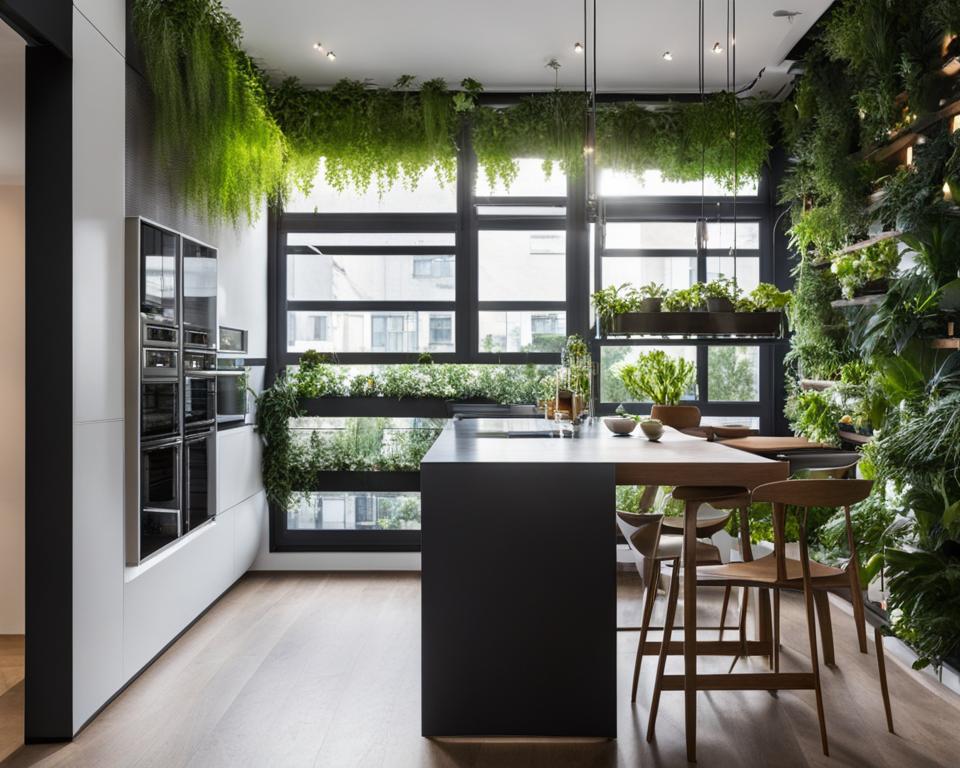
Imagine transforming your snug residence into a lush, leafy oasis with indoor vertical gardening for small spaces. Even the most compact urban living environment has untapped potential to bloom with greenery and vibrancy. Today’s vertical gardening solutions champion smart, stylish, and space-savvy methods to cultivate your private patch of nature.
- Wire Frames: As a sturdy and versatile foundation, wire frames can be mounted on walls or left freestanding, creating a vertical canvas for climbing plants or hanging pots.
- Pegboard Systems: Pegboards offer a customizable grid that accommodates hooks and shelves—perfect for an evolving garden that grows with your ambitions.
- Modular Cinderblocks: Modular cinderblock structures can be stacked and rearranged, fitting snugly into corners or against walls, making them suited for an assortment of plants.
Each method not only serves to green up your space but also turns your living quarters into a conversation piece, brimming with life and creativity.
| Garden Type | Best for Growing | Ideal Placement |
|---|---|---|
| Tower Gardens | Lettuces, Herbs, Strawberries | Patios, Balconies, Corners with Adequate Light |
| Window Boxes | Flowering Plants, Succulents | Sunny Windowsills |
| Wall-Mounted Planters | Decorative Ferns, Small Vegetables | Living Rooms, Kitchens, Hallways |
Don’t be discouraged by the size of your indoor environment. Fusing creativity with practicality, indoor vertical gardening for small spaces taps into your home’s vertical real estate, leaving your floor space uncluttered. It’s time to nurture a thriving vertical garden that not only maximizes your area but also encapsulates nature’s restorative charm.
Upgrading Your Green Thumb with Advanced Vertical Gardening Systems
Gardening enthusiasts looking for the best indoor vertical garden ideas may find that transitioning to advanced vertical gardening systems offers a superior experience. These sophisticated arrangements bring together aesthetics, space efficiency, and state-of-the-art technology to deliver a truly modern approach to urban horticulture. Let’s delve into how you can cultivate a lush indoor oasis with the latest advancements in gardening tech.
Automated Hydroponic Towers for Ease and Productivity
Hydroponic towers redefine what it means to garden indoors, bringing ease and a new level of productivity to your green space. Brands like Tower Garden and Aerofarms have designed these systems to be self-contained, requiring minimal maintenance. Their sleek design fits into even the smallest of apartments, making them one of the most effective advanced vertical gardening systems available today.
The beauty of these towers lies in their automation. Equipped with built-in lights and a water circulation system, they provide your plants with the optimal conditions to thrive all year round. This means consistent, pesticide-free crops that are as nutritious as they are delicious, harvested directly from your living room or kitchen.
Implementing High-Tech Monitoring for Precision Gardening
With the objective of making your indoor garden flourish, integrating high-tech monitoring systems is a game-changer. These systems can range from basic moisture meters to advanced sensors that track various environmental parameters such as humidity, light intensity, and nutrient levels. They send real-time data to your smartphone, allowing for precision adjustments and ensuring that your plants receive exactly what they need for optimal growth.
- Temperature sensors help manage the microclimate around delicate crops.
- Light sensors can automate LED lights for consistent photosynthesis.
- Moisture sensors prompt watering alerts, making sure your plants are never thirsty.
With all these advancements, the transition to smart gardening not only sets a new standard for urban agriculture but also positions you as a part of a sustainable and technologically-advanced gardening movement.
| Feature | Benefits | Examples |
|---|---|---|
| Automated Watering | Consistent moisture, less water waste | Click & Grow, Aerogarden |
| Built-in LED Lighting | Year-round optimal light | Veritable Smart Garden |
| Smart Sensors | Real-time environment control and monitoring | PlantLink, Parrot Flower Power |
| Mobile App Integration | Convenient gardening from your phone | Grow with Jane, Niwa |
By embracing these advanced vertical gardening systems, you’re not just growing plants; you’re nurturing a healthier lifestyle and future. Start exploring these best indoor vertical garden ideas to unlock the full potential of your urban abode.
Side-Stepping Common Challenges in Vertical Gardening Indoors
Delving into the world of vertical gardening indoors brings with it a unique set of challenges. However, anticipating potential pitfalls can help you circumvent them, setting the stage for a flourishing garden, high in the sky within your home. Moisture management is paramount, as unchecked water can seep into your living space, damaging surfaces and compromising the very structure of your indoor oasis.
The choice of plants is another critical factor; some have aggressive root systems that might not be suitable for confined spaces. Likewise, ensuring that the structural integrity of your gardening setup can handle the cumulative weight of plants, soil, and moisture is a safety concern that cannot be overstated. Here are some tips to navigate the complexities of challenges in vertical gardening indoors:
- Use water-resistant barriers to protect against moisture damage to walls and floors.
- Be judicious with your watering schedule to avoid excess humidity that can lead to mold or structural issues.
- Select plants that are adapted to indoor conditions and have suitable root growth for your vertical arrangement.
- Regularly check the support systems of your vertical garden, prioritizing safety and stability.
- Invest in a reliable drip irrigation system to manage water delivery efficiently and prevent overwatering.
Remember, behind every challenge, there’s an opportunity to grow—both as a green-thumbed enthusiast and in cultivating a lush indoor paradise. With consistent care and strategic planning, the rewards of vertical gardening will surely rise above the hurdles you might encounter.
Conclusion
In the realm of modern gardening, vertical gardening indoors stands out as a transformative practice that marries the beauty of greenery with the practicalities of urban living. This innovative approach empowers you to infuse nature into your home, regardless of square footage, and to enjoy the pleasures of gardening and the taste of homemade produce. With the techniques and inspirations shared throughout this article, your journey in indoor vertical gardening should now seem less daunting and more of an exciting adventure waiting to unfold.
As you’ve learned, the essence of a thriving vertical garden lies in the harmonious blend of suitable plants, the right environment, and the creative use of space. Every plant you nurture grows more than fruits and leaves; it grows your skills and deepens your connection to the environment. Embrace each step, from the selection of containers to the careful balancing of light and moisture, as a dance with nature that fortifies both your living space and your well-being.
Ultimately, whether you are decking out your abode with luscious edibles or crafting a tranquil green retreat, the art of indoor vertical gardening invites a cornucopia of benefits into your home. Let these insights be your guide as you elevate your indoor landscape to new heights, harvesting not only crops but also joy and serenity for years to come.
FAQ
What is vertical gardening indoors?
Vertical gardening indoors is an innovative method of growing plants in a vertical space inside your home. It leverages walls, shelving units, and other vertical structures to maximize limited space while providing an opportunity for gardening enthusiasts to cultivate their own food, flowers, or foliage. It’s particularly well-suited for urban dwellers or those with small living spaces.
What are some benefits of indoor vertical gardening?
The benefits of indoor vertical gardening include space maximization, year-round growing, improved mental well-being by bringing nature indoors, and the opportunity for an eco-friendly lifestyle by reducing water usage and eliminating the need for harmful pesticides. Additionally, it can improve air quality and contribute to reducing your carbon footprint.
How can I start vertical gardening indoors?
To start vertical gardening indoors, you need to assess the amount of space and light available in your home and choose an appropriate vertical gardening system — such as hanging pots, pocket gardens, or stackable planters. Then, select suitable plants for your environment, considering factors like lighting and space constraints, and gather all the necessary supplies like soil, seeds or seedlings, and gardening tools.
What are some vertical gardening techniques?
Some popular vertical gardening techniques include using hanging planters, wall-mounted pocket gardens, tiered shelves, trellises, and hydroponic or aeroponic systems. These methods allow for a variety of arrangements and can accommodate a range of plants, from houseplants to edibles, in diverse living spaces.
Can you recommend some plants for my indoor vertical garden?
Yes, some great plants for an indoor vertical garden include leafy greens such as lettuce and spinach, herbs like basil, mint, and chives, and small fruit-bearing plants like strawberries. For decorative purposes, you might consider edible flowers, ferns, or ivies. Choose varieties that match your specific lighting conditions and available space.
How do I maintain moisture and soil health in my vertical garden?
To maintain moisture and soil health in a vertical garden, ensure you have well-draining soil that retains moisture without waterlogging. Water your plants properly; many vertical systems allow water to trickle down from the top, efficiently watering lower plants. Monitor soil moisture levels and fertilize as necessary to maintain nutrient-rich soil conducive to plant growth.
What are creative solutions for vertical gardening in small spaces?
Creative solutions for vertical gardening in small spaces include using wall-mounted systems like pocket gardens, employing hanging baskets, repurposing over-the-door shoe organizers, or creating a modular garden with stackable units. Utilizing the vertical dimension allows for a surprising amount of greenery even in the smallest of areas.
What are some challenges in vertical gardening indoors, and how can I overcome them?
Common challenges include ensuring adequate light, preventing moisture damage to indoor surfaces, choosing plants with suitable root systems, and maintaining structures securely attached to the walls. Overcoming these challenges involves carefully planning the layout of your garden, using waterproof barriers, selecting plants correctly, and monitoring your garden’s health regularly.
What advanced vertical gardening systems can I consider for my home?
For an advanced setup, you might consider hydroponic or aeroponic towers, which allow for soilless cultivation and can be highly productive. There are also stackable units with built-in LED lighting and high-tech systems equipped with sensors and smartphone apps for monitoring temperature, humidity, and water levels, simplifying the maintenance of your garden.
Are there any automated options for vertical indoor gardening?
Yes, there are automated options such as hydroponic systems with integrated watering and nutrient delivery, as well as smart gardens that come with built-in lights, automatic timers, and even app-controlled monitoring systems that can adjust conditions to ensure optimal plant growth.

